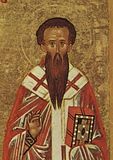

| Previous day | Next day |
| Old Style
February 28
|
Tuesday |
New Style
March 13
|
|
4th Week of Great Lent.
Tone 7.
Great Lent. |
Monastic rule: xerophagy (bread, uncooked fruits and vegetables).
|
![]() St. John Cassian the Roman, abbot, of Marseilles (435).
St. John Cassian the Roman, abbot, of Marseilles (435). ![]() St. Basil the Confessor (ca. 750). St. Arsenius (Matsievich), metropolitan of Rostov, confessor (1772).
St. Basil the Confessor (ca. 750). St. Arsenius (Matsievich), metropolitan of Rostov, confessor (1772).
Hieromartyr Nestor, bishop of Magydos, at Perge in Pamphylia (250). Sts. Marina and Kyra, nuns, of Beroea in Syria (ca. 450). Hieromartyr Proterius, patriarch of Alexandria, and six companions (457). St. John, called Barsanuphius, of Nitria in Egypt (5th c.). St. Theosterictus the Confessor, abbot, of Pelecete Monastery near Prusa (8th c.). Blessed Nicholas of Pskov, fool-for-Christ (1576). St. Cassian, recluse and faster of the Kiev Caves (12th c.). St. Cassian, recluse and faster of the Kiev Caves (12th c.). St. Cassian, founder of Muezersk Hermitage (16th c). St. Cassian, founder of Muezersk Hermitage (16th c). St. Meletius, archbishop of Kharkov (1840).
Apostles of the Seventy Nymphas and Eubulus (1). St. Romanus, desert-dweller of Condat in the Jura Mountains (Gaul) (460). New Virgin-martyr Kyranna of Thessalonica (1751). St. Germanus of Dacia Pontica (Dobrogea, Romania) (5th c.). St. Oswald, archbishop of York (992). St. Barsus of Damascus, bishop
Thoughts for Each Day of the Year
According to the Daily Church Readings from the Word of God
By St. Theophan the Recluse

Tuesday.
Baptism according to Apostle Peter is the answer of a good conscience toward God (I Pet. 3:21).[1] He who has been baptized gives a vow to live the rest of his time according to a pure conscience, according to the whole breadth of the Lord’s commandments, accepted in his conscience. Moral purity is a characteristic of one who is baptized. The Apostle Paul compares the brightness of this life with the brightness of the resurrected Lord. That like as Christ was raised up from the dead by the glory of the Father, even so we also should walk in newness of life (Rom. 6:4). In baptism, the old sin-loving man dies and a new man arises, zealous to do good works. Likewise reckon ye also yourselves, ye who are baptized, to be dead indeed unto sin but alive unto God through Jesus Christ our Lord. Let not sin therefore reign in your mortal body, that ye should obey it in the lusts thereof. Neither yield ye your members as instruments of unrighteousness unto sin: but yield yourselves unto God, as those that are alive from the dead, and your members as instruments of righteousness unto God. For sin shall not have dominion over you (Rom. 6:11–14).
[1]The Slavonic for I Pet. 3:21 reads: the promise of a good conscience toward God
Articles
 Hieromartyr Nestor the Bishop of Magydos in PamphyliaDuring a persecution against Christians under the emperor Decius (249-251), he was arrested while praying in his home. |
 Venerable John-Barsanuphius the Bishop of DamascusSaint John, called Barsanuphius, was a native of Palestine. He was baptized when he was eighteen years old, and later became a monk. |
 Martyr TheokteristusThe Holy Martyr Theokteristus, Igumen of the Pelekete monastery, suffered for the holy icons under the impious emperor Constantine Copronymos (741-775). |










